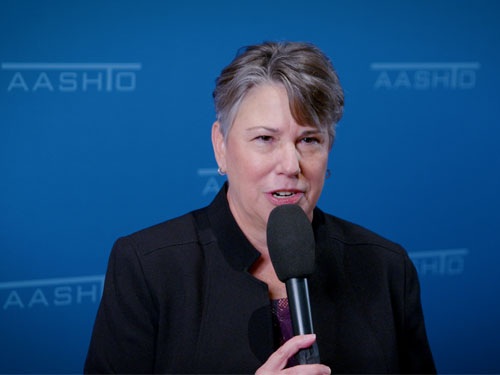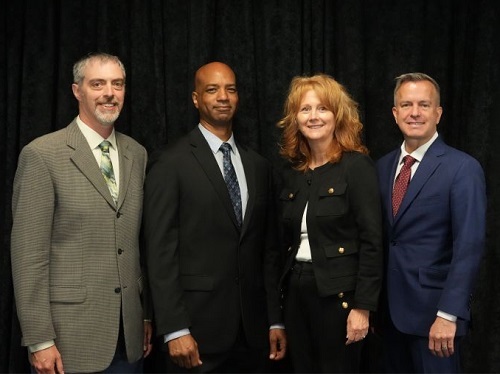Shayne Gill (above at far right) – program director for multimodal transportation at the American Association of State Highway and Transportation Officials – gave the keynote speech at the annual freight summit hosted by the St. Louis Regional Freightway as part of the 2024 FreightWeekSTL conference held in May.
[Above photo via FreightWeekSTL]
The St. Louis Regional Freightway is a regional freight district and comprehensive authority for freight operations and opportunities within eight counties in southwestern Illinois and eastern Missouri, which comprise the St. Louis metropolitan area.
“St. Louis really is the gateway for freight transportation,” said AASHTO’s Gill at the event. “You look at the movement not only east-west, but also north-south, and being in the central part of the country, the St. Louis region is key for multimodal freight connections. You are situated such that you’re not reliant on one mode of transportation. I think that really sets you up for having better opportunities here for economic growth.”

He noted that the “collaborative efforts” on both sides of the Mississippi River – fostered by the leadership of the St. Louis Regional Freightway – are helping to advance key projects.
Specifically, Gill pointed to the partially funded $2.8 billion investment that will create a new single terminal at St. Louis Lambert International Airport; continuing improvements on Interstate 270 in both Missouri and Illinois; and the recently completed replacement of the Merchants Bridge and upcoming improvements to the MacArthur Bridge – both of which provide freight rail service across the Mississippi River in the downtown St. Louis area.
He also highlighted the role of infrastructure investment as an “economic driver” as well, noting that for every $1 of investment in transportation, the return on investment is $4 in economic development.
Thus the St. Louis region’s $2.3 billion “Priority Projects List” translates into close to $10 billion worth of near-term economic impact for St. Louis region. The total for all 27 projects on that list tops $8 billion, meaning they represent $24 billion in economic impact for Missouri and Illinois.
Gill also noted that the region is taking advantage of federal funding that has not been there before, with both states passing additional funding to support significant infrastructure improvements.
“Basically, you have set yourself up in a great way to be able to take advantage of the new funding that’s become available and to advance more projects faster than other parts of the,” he explained.
Gill also talked about the historic funding included in the Infrastructure Investment and Jobs Act or IIJA and how AASHTO hopes to see federal funding at that level continue given the cost of inflation and the cost of construction projects going forward.
“What we are looking to advocate for is that the ‘historic’ levels of funding really should be a baseline of funding moving forward,” Gill said.
“When we have these discretionary grants that come out and you’re able to apply for those, having both states, both transportation departments, but also governors and elected officials all being supportive of those projects is key at the federal level when the U.S. Department of Transportation is making those decisions,” he emphasized. “If they see a priority list, and know that the region is supportive of certain projects, it’s easier for them to fund those types of projects than when you have differing priorities.”
During the question and answer portion of the summit, Gill noted that educating “everyday people” about the benefits of transportation is critical to future infrastructure investments.
“You need to be able to tell those individual stories, because transportation does have a daily effect in a lot of aspects of your life that maybe we don’t, as professionals, share enough,” he pointed out. “Being able to tell individual stories about how transportation is benefiting your life and how that has a ripple effect on society helps when we are asking for additional funding or the need to just keep up with funding for projects.”
 Top Stories
Top Stories
USDOT Makes $1.5B Worth of BUILD Grants Available
December 19, 2025 Top Stories
Top Stories

